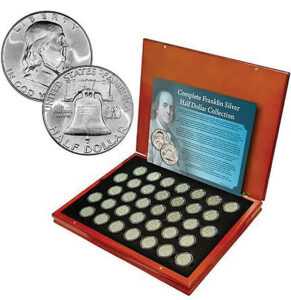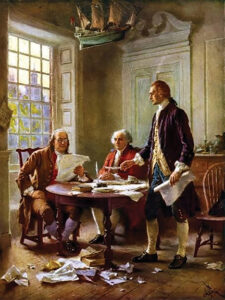 By Barry Krause
By Barry Krause Genuine 18th century Benjamin Franklin collectibles are still available for purchase by collectors.
His authentic autographs are not cheap because of constant strong demand for them, but he was a prolific letter writer and signed many documents in the many important functions he had as a Colonial American patriot, statesman, diplomat, writer, editor, philosopher, inventor, scientist, librarian, postmaster and scholar.
Franklin’s signature all by itself on a small piece of paper is worth $3,375; a document signed (DS) by him is valued at about $8,800 for a typical example; and an “autograph letter signed” (ALS) which is written entirely in Franklin’s own hand starts at around $16,625 at retail today, according to prices listed in The Official Autograph Collector Price Guide by Mark Allen Baker. A Franklin letter with exceptional contents, such as discussing his political decisions or work on inventions, can be worth much more. Not all good Franklin letters are locked up in museums. Some come on the market from time to time.
“On a single day in 1772 he wrote thirteen letters to as many different persons on subjects ranging from the employment problems at a glass factory… to the selection of books for the Philadelphia Library… and the principle of oath taking,” said The American Heritage History of Colonial Antiques (1967).
In his many official and semi-official duties over his long life of 84 years, Franklin signed many documents. Judith Miller’s Antiques Price Guide for 2006 mentions just such an available document for collectors today, a “real estate indenture with manuscript notary addendum signed by Franklin as Justice of the Peace, wax and paper seals,” and worth $5,000 to $8,000 in the current market.
As a professional printer, Franklin made many printings of American Colonial paper currency for individual states when they were still colonies before the Revolutionary War, not personally signed by him, but rather with his imprint identifying his printing shop, such as “Printed by B. FRANKLIN and D. HALL. 1760” which is what we see on a 5 Pound note from Pennsylvania Colony.
Franklin also helped to print Colonial paper money of Delaware, Maryland and New Jersey, but his Colonial Pennsylvania currency is more plentiful, with a worn specimen available today for a couple of hundred dollars or less. Buy only from experienced dealers in Colonial American currency because counterfeits exist, some very crudely done that should fool nobody, but others of better quality as collector forgeries.
 “Contemporary counterfeits” of Franklin’s currency were made while it still circulated in the mid-18th century, and are quite collectible today at modest prices, but watch out for modern reprints artificially aged to fool collectors.
“Contemporary counterfeits” of Franklin’s currency were made while it still circulated in the mid-18th century, and are quite collectible today at modest prices, but watch out for modern reprints artificially aged to fool collectors.
 “Contemporary counterfeits” of Franklin’s currency were made while it still circulated in the mid-18th century, and are quite collectible today at modest prices, but watch out for modern reprints artificially aged to fool collectors.
“Contemporary counterfeits” of Franklin’s currency were made while it still circulated in the mid-18th century, and are quite collectible today at modest prices, but watch out for modern reprints artificially aged to fool collectors. Benjamin Franklin was a skilled writer, and 18th century editions of his Poor Richard’s Almanack and Autobiography bring four figure prices today and are still quoted with Franklin’s timeless phrases of wisdom, such as “God helps them that help themselves” and “Early to be and early to rise, Makes a man healthy, wealthy, and wise.”
Look for original printings of his Almanack which was published annually from 1733 to 1758, and also for copies of The Pennsylvania Gazette newspaper which Franklin printed from 1729 to 1766.
Original paintings and sculptures of Franklin done from life are mostly in museums beyond the reach of any collectors, no matter how wealthy, but “working copies” and old replicas of these art works, some dating from the 18th century, may be found for sale. Cheaper are those made in the 19th century, as a rule.
Often reproduced and imitated by other artists are such famous paintings as John Trumbull’s “Signing of the Declaration of Independence” (painted by Trumbull circa 1786-1819) which depicts Franklin as one of the patriots present, as indeed he was; “Benjamin Franklin Drawing Electricity from the Sky,” painted circa 1816 by Benjamin West and featuring Franklin doing his experiment with a kite and key that proved lightning is electricity; and popular Franklin close-up portraits such as the one done by Joseph Duplessis during the 1780s.
Engravings and sketches of Franklin that were printed in 18th century publications are more desirable than 19th century examples, in general. Be careful of altered dates and questionable provenances (ownership histories).
The so-called “Franklin stove” was actually a clever combination of stove and fireplace device invented by Franklin, although he may have gotten the idea from some European stoves made earlier. Few 18th century examples of Franklin’s stove exist outside museums today, but his writings about his stove in pamphlets and letters may turn up once in a while.
Franklin never patented his inventions of the stove, lightning rod and bifocal eyeglasses, nor used them for personal profit, preferring to let his new ideas to be freely adopted by anyone for the public good.
 After Franklin died, his portrait was widely used on medals, tokens and state banknotes, many of which are for sale today at prices to suit all collecting budgets. After George Washington, Franklin was the early American patriot most often used for street signs and business advertising, and any genuine 18th century examples would be premium items if offered for sale now.
After Franklin died, his portrait was widely used on medals, tokens and state banknotes, many of which are for sale today at prices to suit all collecting budgets. After George Washington, Franklin was the early American patriot most often used for street signs and business advertising, and any genuine 18th century examples would be premium items if offered for sale now.The famous marble busts of Franklin by the French sculptor Jean-Antoine Houdon were first made while Franklin served as an American diplomat in France in the late 1770s, and you can view original examples at the Philadelphia Museum of Art and Metropolitan Museum of Art in New York. Other versions of Houdon’s bust of Franklin are known in plaster and terra-cotta, but replicas and imitations abound, and a fair image of the bust in profile is on the Franklin silver half dollars issued from 1948 through 1963 by the U.S. Mint.
Books about Franklin that were first issued in the 18th century are especially desirable, such as the 1773 first French edition of Oeuvres de M Franklin (“Works of Mr. Franklin”), printed in Paris in small format, and now valued at $2,000; or the Private Life of the Late Benjamin Franklin, published in London in 1793, and worth $750 for a rebound copy, according to Huxford’s Old Book Value Guide.
Benjamin and his brother, James Franklin, are both credited with making nice woodcuts and metalcuts for printing decorations and illustrations on work done in their printing shops. An original piece of printing gear that was actually used by Franklin would bring top dollar today if it could be authenticated accurately. Benjamin Franklin was internationally famous while he was alive. His name and deeds were household knowledge throughout Colonial America and Europe, and he is still one of the best beloved Americans of all time.
As French financier, A.J. Turgot, remarked about Franklin after Franklin successfully negotiated the difficult Treaty of Paris of 1783 that officially ended our Revolutionary War and made America independent as a nation, “He snatched lightning from the sky and the scepter from tyrants.”















Follow Us